THE DOGS OF CHERNOBYL
ABOUT MY GUESTS ERIK AND LUCAS
For the last 4 years, Erik Kambarian and Lucas Hixson, co-founders of the non-profit organization Clean Futures Fund have been traveling to Chernobyl Nuclear Power Plantin Ukraine as part of an international delegation. During their first visit to the zone, they were shocked to discover the large population of stray dogs and puppies that live at the power plant and in the surrounding exclusion zone. Please read about their very important story.
The Dogs of Chernobyl
Many people think of Chernobyl as a post-apocalyptic wasteland, but there are thousands of workers at the infamous nuclear plant and hundreds of stray dogs that live in the surrounding areas. These animals are largely the descendants of pets of people who were evacuated after the nuclear disaster in 1986.
BACKGROUND
In the early morning of April 26th, 1986, there was an accident and catastrophic explosion of the number 4 reactor at the Chernobyl Nuclear Power Plant in northern Ukraine. Radioactive materials quickly spread into the environment, forcing officials in the former Soviet republic to evacuate over 120,000 people from nearly 200 cities and communities around the power plant. By May, the Soviet military had established a 30-kilometer exclusion zone around the stricken plant.
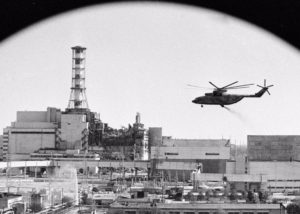
(The unit 4 reactor at the Chernobyl Nuclear Power Plant in former Soviet Ukraine after explosions ripped apart the reactor and released radioactive contamination into the environment).
The displaced were told that they would only be gone a few days. Government officials knew this wasn’t true, but it was the only way to get evacuees to leave in an orderly fashion. Pets were not allowed to be taken, instead, they were abandoned – their owners never to return.
After the evacuations were complete, soldiers were dispatched to shoot and kill the abandoned animals. Not all of the animals were culled. The remaining pets left to the wild, began migrating to areas of the zone where cleanup workers, often called liquidators, worked and stayed during the battle to contain the nuclear catastrophe.

(One of the oldest photographs we have been able to find of the Dogs of Chernobyl. The photo depicts two puppies who had already migrated to the plant within a few weeks of the disaster despite high levels of radiation).
The dogs at the Chernobyl Nuclear Power Plant are generally very young. New litters of puppies are born year-round. Many of the puppies born after October do not survive the harsh Ukrainian winter.
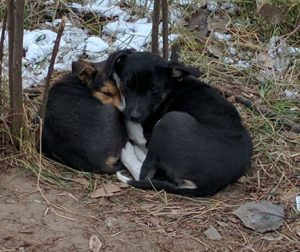
(Two puppies huddled together for warmth in November 2016. They most likely did not survive the harsh winter at Chernobyl).
Over the years, workers at Chernobyl and in the surrounding exclusion zone have attempted to care for these homeless animals – even though it is technically illegal and puts them at potential risk. It is not uncommon for workers to feed the animals or tend to one that is injured.

(This Chernobyl Dog is resting near the plant administration building and has received some assistance for an injury from a compassionate plant worker).
While human interaction is good for the animals and for the workers, it also carries considerable risk. The dogs have been exposed to rabies by animals in the exclusion zone, including the packs of wolves that claim the surrounding areas. There are rules against feeding the stray dogs in the zone, but the worker’s big hearts prevent them from being able to ignore the plight of the animals. The problem with feeding the dogs is that the first thing they want to do after eating is breed – continuing the proliferation of young puppies in the zone.
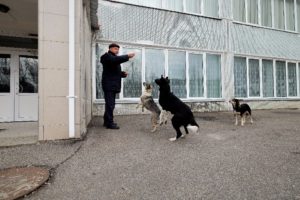
(A plant worker feeds some Chernobyl Dogs outside of the cafeteria).
Out of desperation and lack of funding to care for the dogs, a worker has been assigned to cull the stray dog population around the plant. For the time being, CFF has negotiated a more humane solution to managing the stray animals with our Dogs of Chernobyl Project.
DOGS OF CHERNOBYL PROJECT
In 2016, CFF developed a program to spay, neuter and vaccinate the stray dogs of Chernobyl. This initiative is designed to reduce the risk of human exposure to rabies from coming into contact with the dogs as well as provide basic vaccinations and medical care for these furry friends.
This August, CFF will dispatch a team of experts (who have donated their time) to Ukraine to partner with 3-5 Ukrainian veterinarians, dog handlers, veterinary technicians and over twenty volunteers to spay, neuter, vaccinate and provide basic medical care for as many of the stray animals in the zone as funding allows.
As you can imagine, this is not your typical spay/neuter and vaccination campaign. Special care and handling will be taken during the capture, holding and release of the animals to ensure that all risks are properly managed.
CFF has partnered with the Chernobyl Nuclear Power Plant and Chernobyl Exclusion Zone Management Agency in Ukraine and has official recognition for this unprecedented animal care project.
If you would like to know more or donate please visit www.dogsofchernobyl.com
Every donation gets us closer to helping these forgotten animals!
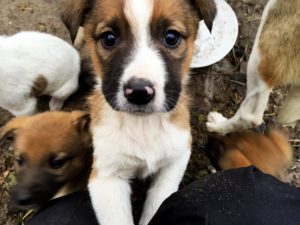 |
||||
|
||||
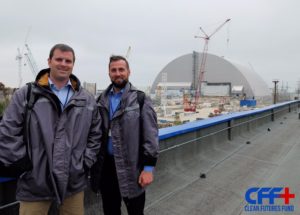
Erik and Lucas at Chernobyl Nuclear Power Plant with the New Safe Confinement structure in the background. This new structure replaces the original sarcophagus and is designed to last 100 years.
www.cleanfutures.org @CleanFutureFund www.facebook.com/cleanfutures
ABOUT MY GUESTS ERIK AND LUCAS
For the last 4 years, Erik Kambarian and Lucas Hixson, co-founders of the non-profit organization Clean Futures Fund have been travelling to Chernobyl Nuclear Power Plantin Ukraine as part of an international delegation. During their first visit to the zone, they were shocked to discover the large population of stray dogs and puppies that live at the power plant and in the surrounding exclusion zone.

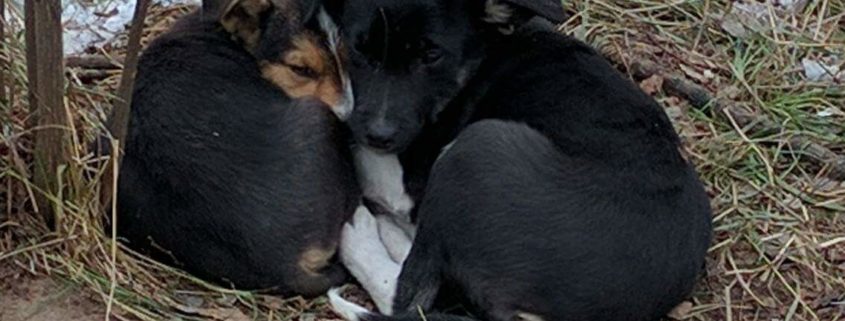


Leave a Reply
Want to join the discussion?Feel free to contribute!